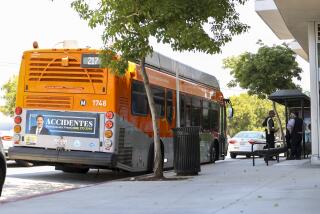Valley Corridor : $17-Million Traffic Flow Plan Unveiled
- Share via
Three San Fernando Valley politicians Tuesday unveiled a major traffic improvement plan designed to cut cross-Valley travel time by installing nearly 300 high-tech signals in a wide corridor between Victory and Ventura boulevards.
Councilman Michael Woo, Councilwoman Joy Picus and Assemblyman Richard Katz (D-Sepulveda) said they will urge the Los Angeles County Transportation Commission to quickly approve $12.5 million in funding for the $17.2-million project.
The commission’s streets and highways committee is expected to approve the proposal at its June 10 meeting, said Marcia Mednick, committee chairwoman. Mednick, who attended Tuesday’s briefing, said she sees no obstacles in obtaining the key committee approval.
The 11-member transportation commission, of which Woo is a member, could give approval as early as June 29, Mednick said.
The commission would use its share of the federal gasoline tax to fund the project if it is approved, said Ginger Gherardi, highway program manager for the commission.
Katz announced Tuesday that state Department of Transportation officials have agreed to provide $1.7 million. Last week, the Los Angeles City Council appropriated $3 million for the project in its tentative 1988-89 budget.
“This is the largest attempt of this nature to move traffic through a large area,” Katz said of the 3-mile-wide swath. “It is a major step in bringing high-tech transportation systems to Los Angeles.”
The project would entail the installation of 297 computerized traffic lights in a 10-mile-long area bordered by Victory Boulevard on the north, Ventura Boulevard on the south, Reseda Boulevard on the west and Clybourn Avenue on the east.
The system, called ATSAC for Automated Traffic Surveillance and Control System, uses a computer to monitor traffic through major intersections and automatically changes green and red lights according to traffic flow.
Sensors embedded in the streets send traffic information to the computer over telephone lines. City transportation officials said the system, which was successfully introduced around the Coliseum area during the 1984 Olympics, saved motorists about 13% in travel time and increased average speed about 15%.
“The system has already proved itself to be an Olympic champion,” Picus said. “We are taking what we learned then and making it work now.”
The lawmakers, who made the announcement at the traffic-snarled intersection of Victory and Sepulveda boulevards during the morning rush hour, said the project would create a viable alternative to the Ventura Freeway.
“Most of the traffic in the Valley is not going downtown or to the Westside; it’s moving back and forth through the Valley,” Katz said.
A similar system will be working by mid-July along Ventura Boulevard between Wilbur Avenue in Reseda and Valley Circle Boulevard in Woodland Hills. Also, the system is being installed in downtown Los Angeles and the areas surrounding the Santa Monica Freeway.
If the proposed Ventura-Victory corridor system is funded within the next two months, officials said that it could be completed by the summer of 1989.
“Valley motorists will be able to experience relief that quickly,” Katz said, adding that the area’s grid street layout is tailor-made for such a synchronized traffic light system.
More to Read
Sign up for Essential California
The most important California stories and recommendations in your inbox every morning.
You may occasionally receive promotional content from the Los Angeles Times.













